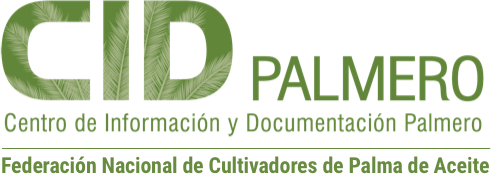| dc.creator | Pérez, Wilson A. | |
| dc.creator | Arias A., Nolver A. | |
| dc.date | 2021-08-06 | |
| dc.identifier | https://publicaciones.fedepalma.org/index.php/palmas/article/view/13505 | |
| dc.description | The Colombian Southwestern Oil Palm Zone (Tumaco, Nariño) had a total of 22,243 hectares planted with in- terspecific hybrid OxG cultivars by 2019, with an average fruit yield of 12.3 t/ha/year, number that is considered low when taking into account that other oil-palm-growing regions exceed 20 t/ha/year. For this reason, it was considered a priority to identify the causes behind such a low production and, based on that, design strategies to achieve higher yields. General findings identified “bunch failure” as one of the possible causes. According to the 2017 Agronomic Committee of the Southwestern Zone, this anomaly was present in more than 30% of the affected fruit bunches, therefore the interest in carrying out a study for quantifying the incidence of bunch failure and identifying possible associated factors. For this purpose, two monitoring hectares were established in a hybrid OxG cultivar for a period of one year at a local plantation, establishing controls for crop management practices. Two representative landscapes of the area were considered: plain terrain and hillock. The baseline re- vealed that the losses in production due to bunch failure in the two types of landscape were 36.9% for the plain terrain and 38.7% for hillock areas. In addition, it was observed that 80% of these spoiled clusters did not present evidence of having received assisted pollination. Hence, it was decided to improve this practice, obtaining improvements starting from a 9.7% efficiency in pollination and reaching an efficiency over 90%. The results achieved showed that the increase in the efficiency of assisted pollination, along with adequate crop management practices —such as maintenance, pruning, application of empty fruit bunches and fertilization—, had a positive effect on the percentage of bunch failure, reaching values below 10%. | en-US |
| dc.description | Para 2019 la Zona Suroccidental palmera de Colombia (Tumaco, Nariño) contaba con 22.243 hectáreas sembradas con cultivares híbridos interespecíficos OxG, con una productividad promedio de fruto de 12,3 t/ha/año, la cual es considerada baja si se tiene en cuenta que otras zonas superan 20 t/ha/año. Por tal razón, se consideró prioritario identificar las causas de este bajo rendimiento y diseñar estrategias para alcanzar cifras superiores. Dentro de las posibles causas se identifica el “malogro de racimos”, anomalía que, de acuerdo con lo registrado en el Comité Agronómico de la Zona Suroccidental del año 2017, reporta valores superiores al 30 % de los racimos afectados, motivo por el cual se realiza un estudio con el propósito de cuantificar la incidencia de esta afectación e identificar posibles factores asociados. Para ello, en una plantación de la zona se establecieron dos hectáreas de seguimiento en un cultivar híbrido OxG durante un periodo de un año, llevando a cabo el control de prácticas de manejo del cultivo. Se consideraron dos paisajes representativos de la zona, como son la planicie y el lomerío. La línea base reveló que las pérdidas en producción para los dos paisajes a causa del malogro fueron de 36,9 y 38,7 % para planicie y lomerío, respectivamente. Además, se observó que 80 % de los racimos malogrados no presentaron evidencias de haber recibido polinización asistida, por lo cual se optó por mejorar esta práctica, partiendo de un 9,7 % de eficiencia en polinización y alcanzando una eficiencia superior a 90 %. Los resultados obtenidos muestran que el aumento en la eficiencia de la labor de polinización, acompañada de prácticas adecuadas de cultivo, como labores de mantenimiento, podas, aplicación de tusa y fertilización, tuvieron un efecto sobre el porcentaje de malogro de racimos, reduciendo su incidencia a valores inferiores a 10 %. | es-ES |
| dc.format | application/pdf | |
| dc.format | text/xml | |
| dc.language | spa | |
| dc.publisher | Fedepalma | es-ES |
| dc.relation | https://publicaciones.fedepalma.org/index.php/palmas/article/view/13505/13246 | |
| dc.relation | https://publicaciones.fedepalma.org/index.php/palmas/article/view/13505/13749 | |
| dc.relation | /*ref*/Arias, N. & Beltran, J. (2016). Diseño y evaluación del programa de manejo nutricional en palma de aceite. Tecnologías para la agroindustria de la palma de aceite: Guía para facilitadores. Bogotá: Cenipalma. | |
| dc.relation | /*ref*/Corley, R. H. V. (1973). Oil palm physiology: A review. En R. L. Wastie & D. A. Earp (eds.), Advances in oil palm cultivation (pp. 37-51). Kuala Lumpur: Incorp. Soc. Planters. Corley, R. H. V. & Tinker P. B. (2009). La palma de aceite (cuarta ed.). Bogotá: Fedepalma. | |
| dc.relation | /*ref*/Crandall, R. & Crandall, R. (2016). La palma. The Salvador Option, 4, 331-339. https://doi. org/10.1017/cbo9781316471081.031 | |
| dc.relation | /*ref*/Ditschar, B. (2016). Buenas prácticas de manejo en el cultivo de palma de aceite en América Latina. Palmas, 37(Especial, Tomo I), 55-56. | |
| dc.relation | /*ref*/Donough, C., Witt, C. & Fairhurst, T. (2009). Yield intensification in oil palm plantations through best management practice. Better Crops International, 93(1), 12-14. | |
| dc.relation | /*ref*/Fairhurst, T. (2016). Identificación y eliminación de las brechas de productividad en el cultivo de la palma de aceite. Palmas, 37(Especial, Tomo I), 41-52. | |
| dc.relation | /*ref*/Forero, D., Hormaza, P., Moreno, L. & Ruíz, R. (2017). Generalidades sobre la morfología y fenología de la palma de aceite. Bogotá: Cenipalma. | |
| dc.relation | /*ref*/Gnych, S. M., Limberg, G. & PaoliRisky, G. (2015). Risky business: Motivating uptake and implementation of sustainability standards in the Indonesian palm oil sector. Bogor: Center for International Forestry Research. | |
| dc.relation | /*ref*/Goh, K. J., Härdter, R., Fairhurst, T. (2003). Fertilizing for maximum return. En R. Härdter & T. H. Fairhurst (eds.), Oil palm: Management for large and sustainable yields (pp. 279-306). Singapur: PPI/PPIC & IPI. | |
| dc.relation | /*ref*/Griffiths, W. & Fairhurst, T. (2003). Implementation of best management practices in an oil palm rehabilitation project. Better Crops International, 17(1), 16-19. | |
| dc.relation | /*ref*/Fedepalma. (2016). La palma de aceite en el departamento de Nariño. http://web.fedepalma. org/sites/default/files/files/infografia_narino.pdf | |
| dc.relation | /*ref*/IPNI. (2012). 4R Plant Nutrition: A manual for improving the management of plant nutrition. IPNI. http://www.ipni.net/4R | |
| dc.relation | /*ref*/Jelsma, I., Woittiez, L. S., Ollivier, J. & Dharmawan, A. H. (2019). Do wealthy farmers implement better agricultural practices? An assessment of implementation of Good Agricultural Practices among different types of independent oil palm smallholders in Riau, Indonesia. Agricultural Systems, 170(November), 63-76. https://doi.org/10.1016/j.agsy.2018.11.004 | |
| dc.relation | /*ref*/Lee, J., Gereffi, G. & Beauvais, J. (2012). Global value chains and agrifood standards: Challenges and possibilities for smallholders in developing countries. Proc. Natl. Acad. Sci., 109(31), 12326-12331. | |
| dc.relation | /*ref*/Liau, S. & Ahmad, A. (1995). Defolation and crop loss in young oil palm. En B. S. Jalami (ed.), Proc.1993 PORIM Int. Palm Oil Congress on Agriculture (pp. 408-427). Kuala Lumpur: Palm Oil Research Institute. | |
| dc.relation | /*ref*/Rhebergen, T., Zingore, S., Giller, K. E., Frimpong, C. A., Acheampong, K., Ohipeni, F. T. & Fairhurst, T. (2020). Closing yield gaps in oil palm production systems in Ghana through Best Management Practices. European Journal of Agronomy, 115(April 2019), 126011. https://doi.org/10.1016/j.eja.2020.126011 | |
| dc.relation | /*ref*/Romero, H. M. (2018). Polinización artificial de híbridos OxG para la obtención de frutos partenocárpicos y la producción de aceite (Elaeis oleifera Cortés x Elaeis guineensis Jacq.). El Palmicultor, 558, 15-18. | |
| dc.relation | /*ref*/Rincón, A., Garzón, A. & Torres, J. (2016). Suelos por tipo de paisaje asociados al cultivo de la palma de aceite en la Zona Suroccidental de Colombia. Palmas, (37) 25-43. | |
| dc.relation | /*ref*/Sanchez, A., Daza, E., Ruíz, R., Romero, H. M. (2013). Polinización asistida en palma de aceite. Tecnologías para la agroindustria de la palma de aceite: Guía para facilitadores. Bogotá: Cenipalma. | |
| dc.relation | /*ref*/Schoneveld, G. C., vander Haar, S., Ekowati, D., Andrianto, A., Komarudin, H., Okarda, B. & Pacheco, P. (2019). Certification, good agricultural practice and smallholder heterogeneity: Differentiated pathways for resolving compliance gaps in the Indonesian oil palm sector. Global Environmental Change, 57(July). https://doi.org/10.1016/j.gloenvcha.2019.101933 | |
| dc.relation | /*ref*/Soliman, T., Lim, F. K. S., Lee, J. S. H. & Carrasco, L. R. (2016). Closing oil palm yield gaps among Indonesian smallholders through industry schemes, pruning, weeding and improved seeds. Royal Society Open Science, 3(8), 160292. | |
| dc.relation | /*ref*/Sparnaaij, L. D. (1960). The analysis of bunch production in the oil palm. Afr. Inst. Oil Palm | |
| dc.relation | /*ref*/Res., 3, 109-180. | |
| dc.rights | https://creativecommons.org/licenses/by-nc-nd/4.0 | es-ES |
| dc.source | Palmas; Vol. 42 Núm. 2 (2021); 82-92 | es-ES |
| dc.source | 2744-8266 | |
| dc.source | 0121-2923 | |
| dc.subject | Agronomic practices | en-US |
| dc.subject | Assisted pollination | en-US |
| dc.subject | Yield | en-US |
| dc.subject | Prácticas agronómicas | es-ES |
| dc.subject | Polinización asistida | es-ES |
| dc.subject | Rendimiento | es-ES |
| dc.title | Reduction of Oil Palm Bunch Failure in OxG Hybrid Cultivars (Elaeis oleifera x Elaeis guineensis) through the Deployment of Good Practices | en-US |
| dc.title | Reducción del malogro en racimos de cultivares híbrido OxG (Elaeis oleifera x Elaeis guineensis) mediante el uso de buenas prácticas | es-ES |
| dc.type | info:eu-repo/semantics/article | |
| dc.type | info:eu-repo/semantics/publishedVersion | |


